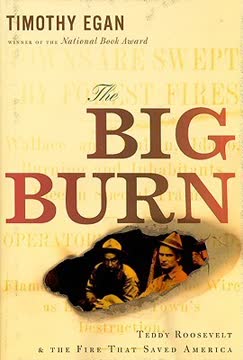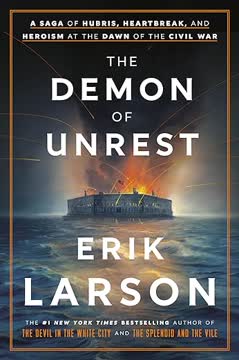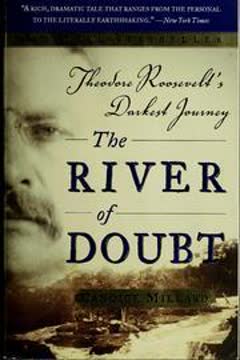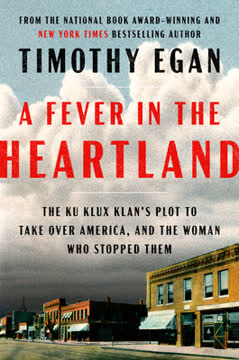Key Takeaways
1. Roosevelt and Pinchot Forged a Radical Conservation Vision
"The earth, I repeat, belongs of right to all its people, and not to a minority, insignificant in numbers but tremendous in wealth and power."
Shared ideals. Theodore Roosevelt and Gifford Pinchot, both privileged New Yorkers, developed a profound love for the outdoors and a revolutionary vision for America's natural resources. Their friendship, forged through shared adventures like wrestling and wilderness treks, became the bedrock of the burgeoning conservation movement. Roosevelt, transformed by his time in the Badlands after personal tragedy, believed the West offered renewal, while Pinchot, a Yale-trained forester, saw a "gigantic and lamentable massacre" in the unchecked exploitation of the land.
A radical philosophy. Their core belief was that vast tracts of wild America belonged to everyone, a "birthright" to be managed for the "common good" rather than private gain. This was a radical departure from the prevailing "cut-and-run" philosophy of the Gilded Age. Roosevelt, using his "bully pulpit," and Pinchot, with his scientific approach, championed the idea that the nation's forests, rivers, and wildlife were a collective inheritance for future generations.
Laying the groundwork. Together, they expanded national forests, created wildlife refuges, and established the U.S. Forest Service in 1905, with Pinchot as its first Chief. This agency was tasked with protecting public lands, a mission Pinchot saw as a "Great Crusade." Their audacious plan quadrupled national forests to nearly 180 million acres, setting a precedent for public land management that would define American environmental policy for a century.
2. The Forest Service: A Young Agency Under Constant Attack
"The transfer meant a revolutionary change. We had the power, as we had the duty, to protect the Reserves for the use of the people, and that meant stepping on the toes of the biggest interests in the West. From that time on, it was fight, fight, fight."
Underfunded and scorned. The newly formed Forest Service, just five years old in 1910, faced immense challenges, operating on a shoestring budget and staffed by young, often inexperienced "Little G.P.s" (Pinchot's acolytes). These rangers, many fresh out of Yale's new forestry school, were tasked with overseeing millions of acres, often without basic tools, roads, or communication. They were frequently ridiculed as "Teddy's boy scouts" or "hapless elites" by locals and powerful interests.
Political opposition. Congress, influenced by powerful "robber barons," actively sought to undermine the Forest Service. They slashed budgets, withheld pay raises, and tried to strip the president's authority to create new reserves. Senator Weldon Heyburn of Idaho, a staunch opponent, famously declared, "Not one cent for scenery!" and questioned the very legitimacy of forestry as a science or a government function.
Frontier lawlessness. Rangers like Elers Koch and Bill Weigle found themselves policing lawless boomtowns like Taft and Grand Forks, which sprang up within national forest boundaries. These settlements, fueled by mining and railroad construction, were rife with:
- Prostitution and gambling
- Timber theft and fraudulent homesteading
- Open defiance of federal authority
Rangers often had to use their own meager salaries to fund operations or pay firefighters, highlighting the severe lack of government support.
3. The West's "Robber Barons" Fought Public Ownership
"The American Colossus was fiercely intent on appropriating and exploiting the riches of the richest of all continents — grasping with both hands, reaping where he had not sown, wasting what he thought would last forever."
Unchecked exploitation. Powerful industrialists and railroad magnates viewed the vast public lands of the West as a "plunderer's buffet." Figures like William A. Clark (Copper King), James J. Hill (Empire Builder), J.P. Morgan, and the Rockefeller family amassed immense fortunes by exploiting natural resources, often through:
- Massive land grants to railroads (e.g., Northern Pacific received 40 million acres)
- Indiscriminate logging and mining
- Buying political influence and judicial decisions
A clash of ideologies. These titans, accustomed to operating without restraint, saw Roosevelt and Pinchot's conservation efforts as an impediment to progress and profit. Senator Clark, who openly boasted about buying politicians, dismissed calls for future generations, stating, "Those who succeed us can well take care of themselves." Their newspapers actively campaigned against the Forest Service, portraying rangers as outsiders and the conservation movement as a "radical" overreach.
Fraudulent homesteads. Even homesteading, intended for small farmers, was co-opted by timber companies. Agents would stake 160-acre claims on forested land, build a token shack, and then sell the "agricultural" land to logging syndicates, circumventing laws designed to protect public timber. This systematic fraud further eroded the national forests and fueled the "robber barons'" wealth, intensifying the conflict between private interests and the public good.
4. A Summer of Smoke Preceded the Cataclysmic Blowup
"The woods wanted to burn."
Unprecedented drought. The summer of 1910 brought an extreme and prolonged drought to the northern Rockies, turning vast forests into tinderboxes. June and July saw less than one-tenth of an inch of rain, and the air was so dry it resembled the Mojave Desert. This created an environment where:
- Pine needles and twigs cracked underfoot
- Mountain meadows and wildflowers withered early
- Creeks and flumes, usually abundant, dwindled to trickles
Escalating fires. The dry conditions led to an explosion of lightning-sparked fires, with hundreds reported daily across Montana, Idaho, and Washington. Coal-burning trains, a symbol of industrial progress, also ignited countless blazes along their routes. Rangers, already stretched thin and underfunded, struggled to contain these "spot blazes," often working 14-hour days with minimal equipment.
Foreboding atmosphere. An eerie sense of dread settled over the region. Smoke became a constant presence, clouding sunrises and turning sunsets blood-red. Despite the escalating danger, local communities, often hostile to the Forest Service, were reluctant to help. Supervisor Bill Weigle struggled to recruit firefighters in Wallace, noting, "While there are plenty of idle men in Wallace or vicinity, they refuse to accept work of any kind." This widespread complacency and lack of cooperation set the stage for the impending disaster.
5. The Big Burn: A Hurricane of Fire Engulfed the Rockies
"All hell broke loose."
The Palouser's fury. On August 20, 1910, a powerful windstorm, a "Palouser," swept into the northern Rockies, transforming thousands of small, smoldering fires into a single, monstrous firestorm. This wind, reaching hurricane-force speeds of 80 miles per hour, created its own weather system, compressing fire-laden air into funnels of flame. The fire moved with terrifying speed and intensity, consuming everything in its path.
Unimaginable scale. The Big Burn, as it became known, engulfed an area of nearly 3.2 million acres—larger than the state of Connecticut—in just two days. It was a "chain reaction" of destruction:
- Flames leaped from treetop to treetop (crown fires)
- Pine sap hissed and exploded, sending firebrands miles ahead
- Trees three centuries old were uprooted and mowed down like grass
- Creeks boiled with dead trout, and animals suffocated or were crushed
Widespread devastation. The firestorm swept across multiple national forests, including the Coeur d'Alene, Lolo, Nez Perce, and Clearwater, and even crossed into British Columbia. Smoke drifted as far east as Chicago and dissipated over Greenland, a stark reminder of the catastrophe. Towns like Taft and Grand Forks were wiped off the map, while Wallace and Avery faced imminent destruction, their fate hanging by a thread as the inferno raged.
6. Heroism Amidst Chaos: Pulaski, Soldiers, and Immigrants
"The next man who tries to leave the tunnel," said Pulaski, "I will shoot."
Pulaski's desperate stand. As the firestorm hit, Forest Ranger Ed Pulaski, a seasoned woodsman, found himself leading 45 panicked firefighters. With flames closing in and escape impossible, he forced his men at gunpoint into a disused mine tunnel, threatening to shoot anyone who tried to flee. Despite being blinded and severely burned, Pulaski's decisive action saved 41 lives, though five men perished in the tunnel's suffocating heat and smoke.
Buffalo Soldiers' valor. President Taft dispatched 2,500 Army troops, including the all-black 25th Infantry, known as Buffalo Soldiers, to fight the fires. Despite facing racial prejudice and being initially viewed with skepticism, these soldiers performed heroically. In Avery, under Lieutenant Edson E. Lewis, they:
- Organized an orderly evacuation of women and children
- Fought the fire with backfires and water buckets
- Saved the town from complete destruction
Their actions earned them widespread praise, with one paper noting, "They were black, but I never knew a whiter set of men to breathe."
Immigrants' sacrifice. Thousands of immigrants, many from Italy, were recruited as firefighters, often with little experience and only the promise of pay. Domenico Bruno and Giacomo Viettone, two friends from Rivara Canavese, Italy, who had sought a better life in America, died alongside five others in a shallow root cellar in Beauchamp's clearing. Their bodies were burned beyond recognition, and they were initially listed as "two unidentified Italians," their sacrifice for a new country largely anonymous.
7. The Big Burn's Political Aftermath: Conservation's Defining Moment
"Conservation is a great moral issue!"
Pinchot's rallying cry. Gifford Pinchot, though fired by President Taft, seized on the Big Burn as a powerful rallying cry for conservation. He blamed the "ironbound reactionaries" in Congress, particularly Senator Heyburn, for underfunding the Forest Service and leaving the forests vulnerable. Pinchot argued that the catastrophe was "wholly unnecessary" and could have been avoided with adequate resources, transforming the disaster into a political weapon.
Roosevelt's return. Theodore Roosevelt, back from Africa and touring the West, echoed Pinchot's sentiments, praising the Forest Service's valor and competence despite congressional undermining. His "New Nationalism" speech in Osawatomie, Kansas, just days after the fire, declared conservation a "great moral issue" and a central tenet of his progressive platform, further galvanizing public support. This speech, largely penned by Pinchot, marked Roosevelt's open challenge to Taft.
Legislative triumph. The public outrage and heroic narratives surrounding the Big Burn dramatically shifted public opinion. Senator Heyburn's attempts to dismantle the Forest Service and privatize burned lands were defeated. Instead, the disaster paved the way for the Weeks Act of 1911, which allowed the federal government to purchase private lands in the East for national forests. This landmark legislation expanded the public land system by over 20 million acres, solidifying conservation as a permanent American principle.
8. A Flawed Legacy: Aggressive Fire Suppression and Its Consequences
"Forest fires are preventable."
The "10 o'clock rule." The Big Burn, despite its human cost, cemented the Forest Service's mission and public support. However, it also led to a flawed policy of universal fire suppression. Chief Forester Bill Greeley, deeply affected by the devastation, vowed that "fire would never win again." In 1935, the agency implemented the "10 o'clock rule," mandating that any fire must be controlled by 10 AM the following morning.
Ecological imbalance. This aggressive "fire out" policy, while initially seen as a triumph of human control over nature, had unforeseen ecological consequences. Forests, naturally adapted to periodic burns, became:
- Overburdened with dry, aging timber and underbrush (fuel)
- Unhealthy and susceptible to insect infestations
- Prone to even larger, hotter, and more destructive wildfires when they inevitably occurred
A shift in mission. Under Greeley, who later left the Forest Service for the timber industry, the agency's focus shifted from Pinchot's vision of "working forests" for the "little man" to protecting timber for large-scale industrial logging. Taxpayers funded roads and fire suppression, while industry reaped profits from centuries-old trees. This co-option of the Forest Service's mission, driven by the fear of another 1910, created a cycle of escalating fire budgets and increasingly severe fires.
9. The Enduring Spirit of the Land and Its Protectors
"The most remote pocket of the Coeur d'Alenes is just as Pulaski had experienced it on those Sunday picnics with Emma, just as Roosevelt envisioned it, just as Pinchot remembered seeing it for the first time, taking his breath away—there for fresh eyes, for people yet to be born, there to be discovered anew."
Healing scars. Decades after the Big Burn, the Bitterroot Mountains slowly healed, though deep scars remained. The Forest Service, through trial and error, learned that nature's processes, including fire, were essential for forest health. The "10 o'clock rule" was eventually re-evaluated, leading to a more nuanced approach to fire management, acknowledging that "fire is neither good nor bad. It just is."
Personal legacies. The individuals who shaped this era left lasting marks:
- Ed Pulaski, though denied a hero's medal, is immortalized by the "Pulaski" tool, a firefighter's essential.
- Joe Halm flourished in the Forest Service, his survival story a testament to resilience.
- Elers Koch, a loyal "Little G.P.," continued to advocate for wilderness, his name now on a mountain.
- Pinkie Adair, the feisty homesteader, lived to be 94, her story a vivid link to the fire's chaos.
A transformed landscape. The Big Burn, a catastrophic event, ultimately reshaped American conservation. It solidified the Forest Service's role, expanded public lands, and forced a re-evaluation of humanity's relationship with wild nature. Today, vast wilderness areas, protected from logging and development, stand as a testament to the enduring vision of Roosevelt and Pinchot, ensuring that future generations can still discover the untamed beauty of the American West.
Last updated:
Review Summary
The Big Burn receives mostly positive reviews, with readers praising Egan's storytelling and historical research. The book explores the 1910 wildfire that ravaged the Northwest, while also delving into the creation of the U.S. Forest Service and the conservation efforts of Theodore Roosevelt and Gifford Pinchot. Some readers found the narrative compelling and informative, while others felt it lacked focus or oversimplified certain aspects. Many appreciated the book's relevance to current environmental and political issues, as well as its portrayal of the heroic efforts of early forest rangers.
Similar Books
Download PDF
Download EPUB
.epub digital book format is ideal for reading ebooks on phones, tablets, and e-readers.








